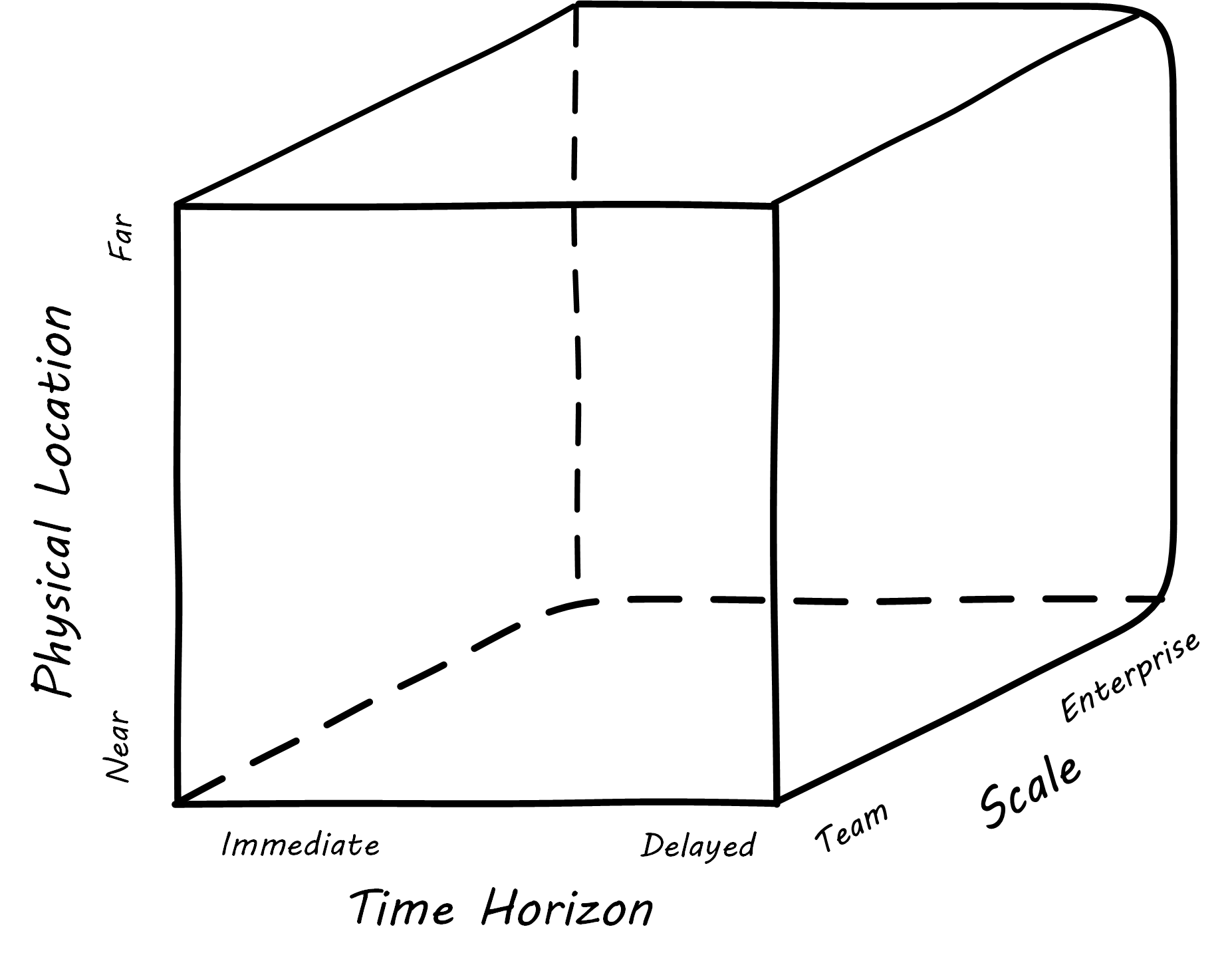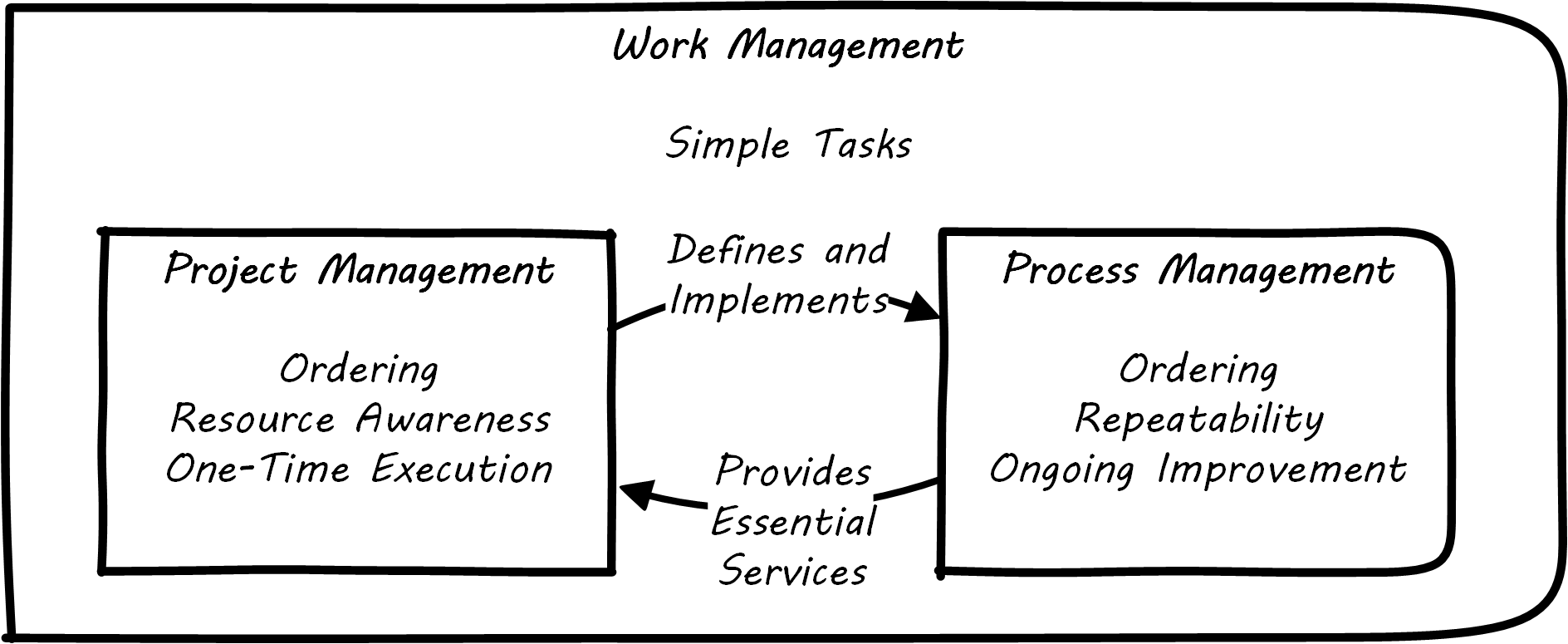Coordination, Execution, and the Delivery Models
Description
If we take the strategies proposed by Strode et al. and think of them as three, orthogonal dimensions, we can derive another useful three-dimensional figure (see Cube Derived from Strode):
-
Projects often are used to create and deploy processes; a large system implementation (e.g., of an Enterprise Resource Planning (ERP) module such as Human Resource Management) will often be responsible for process implementation including training
-
As environments mature, product, and/or project teams require process support

-
At the origin point, we have practices like face-to-face meetings at various scales
-
Geographically distant, immediate coordination is achieved with messaging and other forms of telecommunications
-
Co-located but asynchronous coordination is achieved through shared artifacts like Kanban boards
-
Distant and asynchronous coordination again requires some kind of telecommunications
The Z-axis is particularly challenging, as it represents scaling from a single to multiple and increasingly organizationally distant teams. Where a single team may be able to maintain a good sense of common ground even when geographically distant, or working asynchronously, adding the third dimension of organizational boundaries is where things get hard. Larger-scale coordination strategies include:
-
Operational digital processes (Digital Operations)
-
Change management
-
Incident management
-
Request management
-
Problem management
-
Release management
-
-
Specified decision rights
-
Projects and project managers (Investment and Portfolio)
-
Shared services and expertise (Investment and Portfolio)
-
Organization structures (Organization and Culture)
-
Cultural norms (Organization and Culture)
-
Architecture standards (Information Management and Architecture and Portfolio)
All of these coping mechanisms risk compromising to some degree the effectiveness of co-located, cross-functional teams. Remember that the high-performing product team is likely the highest-value resource known to the modern organization. Protecting the value of this resource is critical as the organization scales up. The challenge is that models for coordinating and sustaining complex digital services are not well understood. IT organizations have tended to fall back on older supply-chain thinking, with waterfall-derived ideas that work can be sequenced and routed between teams of specialists. (More on this to come in Organization and Culture.)
| We recommend you review the definitions of the “three Ps”: product, project, and process management. |
Product Management Release Trains
Where project and process management are explicitly coordination-oriented, product management is broader and focused on outcomes. As noted previously, it might use either project or process management to achieve its outcomes, or it might not.
Release management was introduced in Context I, and has remained a key concept we return to now. Release management is a common coordination mechanism in product management, even in environments that do not otherwise emphasize processes or projects. At scale, the concept of a “release train” is seen. SAFe considers it the “primary value delivery construct” [SAFe 2016].
The train is a cadenced synchronization strategy. It “departs the station” on a reliable schedule. As with Scrum, date and quality are fixed, while the scope is variable. SAFe emphasizes that “being on the train” in general is a full-time responsibility, so the train is also a temporary organizational or programmatic concept. The release train “engineer” or similar role is an example of the coordinator role seen in the Strode coordination tools and techniques matrix.
The release train is a useful concept for coordinating large, multi-team efforts, and is applicable in environments that have not fully adopted Agile approaches. As Joanna Rothman notes: “You can de-scope features from a particular train, but you can never allow a train to be late. That helps the project team focus on delivering value and helps your customer become accustomed to taking the product on a more frequent basis” [Rothman 2011].
Project Management as Coordination
| We will talk about project management as an investment strategy in a future section. In this Competency Area, we look at it as a coordination strategy. Project management adds concerns of task ordering and resource management, for efforts typically executed on a one-time basis. Project management groups together a number of helpful coordination tools which is why it is widely used. These tools include: |
-
Sequencing tasks
-
Managing task dependencies
-
Managing resource dependencies of tasks
-
Managing overall risk of interrelated tasks
-
Planning complex activity flows to complete at a given time
However, project management also has a number of issues:
-
Projects are by definition temporary, while products may last as long as there is market demand
-
Project management methodology, with its emphasis on predictability, scope management, and change control, often conflicts with the product management objective of discovering information (see the discussion on Lean Product Development)
(But not all large management activities involve the creation of new information! Consider the previous example of upgrading the RAM in 80,000 POS terminals in 2,000 stores.)
The project paradigm has a benefit in its explicit limitation of time and money, and the sense of urgency this creates. In general, scope, execution, limited resources, deadlines, and dependencies exist throughout the digital business. A product manager with no understanding of these issues, or tools to deal with them, will likely fail. Product managers should, therefore, be familiar with the basic concepts of project management. However, the way in which project management is implemented, the degree of formality, will vary according to need.
A project manager may still be required, to facilitate discussions, record decisions, and keep the team on track to its stated direction and commitments. Regardless of whether the team considers itself “Agile”, people are sometimes bad at taking notes or being consistent in their usage of tools such as Kanban boards and standups.
It is also useful to have a third party who is knowledgeable about the product and its development, yet has some emotional distance from its success. This can be a difficult balance to strike, but the existence of the role of Scrum coach is indicative of its importance.
We will take another look at project management, as an investment management approach, in Investment and Portfolio.
Decision Rights
Approvals are a particular form of activity dependency, and since approvals tend to flow upwards in the organizational hierarchy to busy individuals, they can be a significant source of delay and, as Donald Reinertsen points out [Reinertsen 1997], discovering “invisible electric fences” by trial and error is both slow and also reduces human initiative. One boundary spanning coordination artifact an organization can produce as a coordination response is a statement of decision rights; for example, a RACI analysis.
RACI stands for:
-
Responsible
-
Accountable (sometimes understood as Approves)
-
Consulted
-
Informed
A RACI analysis is often used when accountability must be defined for complex activities. It is used in process management, and also is seen in project management and general organizational structure, as shown in RACI Analysis.
| Team Member | Product Owner | Chief Product Owner | |
|---|---|---|---|
Change interface affecting two modules |
Responsible |
Accountable |
Informed |
Change interface affecting more than two modules |
Responsible |
Informed |
Accountable |
Hire new team member |
Consulted |
Responsible |
Accountable |
Some Agile authors[1] call for an “ECI” matrix, with the “E” standing for “Empowered”, defined as both “Accountable” and “Responsible”, and with the “C” standing for “Consulted” and the “I” standing for “Informed”.
Process Management as Coordination
We discussed the emergence of process management in Work Management, and in Digital Operations the basic digital processes of change, incident, problem, and request management.
As we saw in the Strode dependency taxonomy, waiting on a business process is a form of dependency. But business processes are more than just dependency sources and obstacles; they themselves are a form of coordination. In Strode’s terms, they are a boundary spanning activity. It is ironic that a coordination tool itself might be seen as a dependency and blockage to work; this shows at least the risk of assuming that all problems can or should be solved by tightly specified business processes!
Like project management, process management is concerned with ordering, but less so with the resource load (more on this to come), and more with repeatability and ongoing improvement. The concept of process is often contrasted with that of function or organization. Process management’s goal is to drive repeatable results across organizational boundaries. As we know from our discussion of product management, developing new products is not a particularly repeatable process. The Agile movement arose as a reaction to misapplied process concepts of “repeatability” in developing software. These concerns remain. However, this document covers more than development. We are interested in the spectrum of digital operations and effort that spans from the unique to the highly repeatable. There is an interesting middle ground of processes that are at least semi-repeatable. Examples often found in the large digital organization include:
-
Assessing, approving, and completing changes
-
End-user equipment provisioning
-
Resolving incidents and answering user inquiries
-
Troubleshooting problems
We will discuss a variety of such processes, and the pros and cons of formalizing them, in Organization and Culture. In Governance, Risk, Security, and Compliance, we will discuss IT governance in depth. The concept of “control” is critical to IT governance, and processes often play an important role in terms of control.
Just as the traditional IT project is under pressure, there are similar challenges for the traditional IT process. DevOps and continuous delivery are eroding the need for formal change management. Consumerization is challenging traditional internal IT provisioning practices. And self-service help desks are eliminating some traditional support activities. Nevertheless, any rumors of an “end to process” are probably greatly exaggerated. Measurability remains a concern; the Lean philosophy underpinning much Agile thought emphasizes measurement. There will likely always be complex combinations of automated, semi-automated, and manual activity in digital organizations. Some of this activity will be repeatable enough that the “process” construct will be applied to it.
Projects and Processes
Project management and process management interact in two primary ways, as Process and Project illustrates:
-
Projects often are used to create and deploy processes ” a large system implementation (e.g., of an ERP module such as Human Resources Management) will often be responsible for process implementation including training
-
As environments mature, product and/or project teams require process support

As Gary Richardson notes in Project Management Theory and Practice: “there are many organizational processes that are needed to optimally support a successful project” [Richardson 2010]. For example, the project may require predictable contractor hiring, or infrastructure provisioning, or security reviews. The same is true for product teams that may not be using a “project” concept to manage their work. To the extent these are managed as repeatable, optimized processes, the risk is reduced. The trouble is when the processes require prioritization of resources to perform them. This can lead to long delays, as the teams performing the process may not have the information to make an informed prioritization decision. Many IT professionals will agree that the relationship between application and infrastructure teams has been contentious for decades because of just this issue. One response has been increasing automation of infrastructure service provisioning (private and external cloud).
Evidence of Notability
Coordination is a management fundamental. The basic models presented here (product management, project management, and process management) all have extensive bodies of literature and communities of practitioners.
Limitations
Coordination is costly, and the more that there are requirements for it to scale or be exactly precise, the more expensive it is.
Related Topics